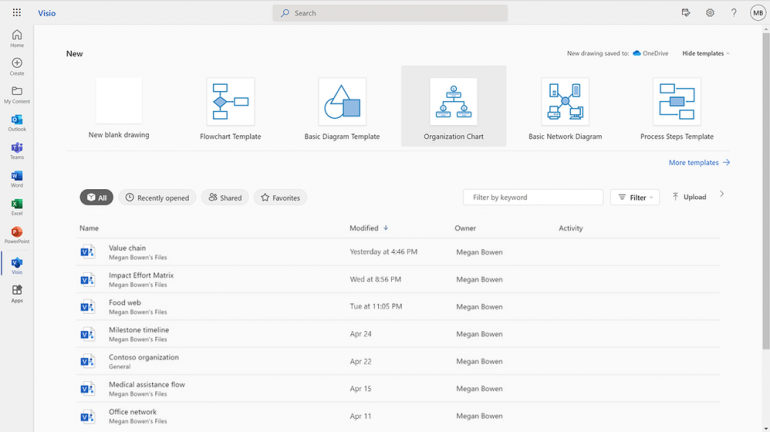
When Microsoft first acquired Visio back in 2000, it was a general-purpose diagramming tool for drawing flow charts, floor plans, org charts, mind maps and network diagrams by dragging shapes onto a canvas and creating connections between them.
Bundling it with Visual Studio and including add ons that could automatically discover network topologies to create those network diagrams (or connect to other data sources that include metadata) made it a popular tool for IT admins and architects. The fact that it was always a separate purchase rather than included in the standard Office suite – where Word and PowerPoint had basic diagramming features – reinforced the view that it was more of a specialist tool.
SEE: Feature comparison: Time tracking software and systems (TechRepublic Premium)
But almost everyone needs to draw diagrams sometimes, especially for explaining or designing processes.
Visio as an online service
As with Project, by turning Visio into an online service, Microsoft could create a simpler version of the software that would be useful to more people on more platforms (there was never a Mac version of the desktop Visio software, for example), while gradually adding options like network mapping and Universal Modeling Language support that made it so popular with more advanced users – but still keeping the desktop software for those who need the full range of features.

The online version of Visio has hundreds of shapes and dozens of templates for block diagrams, business matrices, Venn diagrams, cycle diagrams, flowcharts, org charts, network diagrams, pyramid diagrams and process diagrams, plus more business-specific diagrams like infographics, roadmaps and visual timelines.
This includes popular business frameworks like 5 whys, the 4 P’s of marketing, PESTLE analysis and other specific ways of presenting information visually that you now don’t have to create from scratch each time.

You can also build your own diagrams from the various shapes, with smart guidelines to help you align them on the page, then drag connectors from one shape to another.
Diagrams are automatically saved into OneDrive by default in the Documents folder, but you can move them individually and export as an image, PDF or HTML code for embedding the diagram on a web page). If you have access to the desktop version of Visio, you can send the diagram from the web app, just like opening a document into any other Office app.
And because it’s web based with APIs, you can use Visio inside Microsoft Teams so people can collaborate on diagrams. If you were drawing the diagram in Word or PowerPoint, all you could share would be a static image, not something colleagues can make changes to – and you’d have to clip or save it first. You can combine Visio diagrams with Power BI reports in Teams so you can discuss how well processes are working and see where they might need improving.
To implement a process, you can even take your Visio diagram, open it in Power Automate and connect up the different services and data sources to implement it as an automation flow. If you have a data source, you can use Visio to automatically turn that into a diagram that you can then automate.
Visio also works as an add-in inside Excel, so if you have a list of staff in a spreadsheet, you can turn that into an org chart, which you can then open in the full Visio web app to work on with more tools, and still get the updated diagram back in Excel.
Free for some

Using Visio as an add-on in Office never needed a Visio license, and you could always add Visio as a tab in Teams, but editing a diagram there needed a Visio Plan 1 or Plan 2 subscription. Last year, Microsoft added a basic version of the Visio web app to Microsoft 365, making it available without an extra license for anyone with an Office 365 or Microsoft 365 commercial subscription.
That doesn’t include small and medium business plans like Business Basic and Business Standard, or subscriptions for frontline workers, like F1: You need to have one of Microsoft 365 Business Basic, Microsoft 365 Business Standard, Microsoft 365 Business Premium, Microsoft 365 Apps for business, Office 365 E1, Office 365 E3, Office 365 E5, Office 365 F3, Microsoft 365 F3, Microsoft 365 E3, Microsoft 365 E5, Microsoft 365 Apps for enterprise, Office 365 A1, Office 365 A3, Office 365 A5, Microsoft 365 A1, Microsoft 365 A3 or Microsoft 365 A5.
SEE: Windows, Linux, and Mac commands everyone needs to know (free PDF) (TechRepublic)
There’s no personal version of Visio either, even though there are templates like Home Network that would obviously be useful at home. But Microsoft also still offers Visio Plan 1 and Plan 2 subscriptions, and those get you extra diagram styles for cross-functional flowcharts and swim-lane diagrams, shapes for network equipment and cloud services, and support for UML 2.5.

There aren’t many extra options in Plan 1 over what you can do by just having Microsoft 365. But Plan 2 has a range of more powerful features, like creating a stencil of multiple shapes that you can reuse, using rules to validate diagrams (and fix any that don’t follow the rules, like not connecting more devices to a router than there are ports on it), modeling how a process works using a formal specification or generating diagrams based on data in Excel, Exchange or Azure Active Directory.
It also has more visual effects like adding shadows and bevels to objects or grouping them together, as well as layouts for Gantt and PERT charts, ITIL and Six Sigma diagrams, maps, floor plans, mind maps, wireframes you can use to design apps and websites and more advanced network layout options and shapes.
If you want to use a Visio diagram in Word or PowerPoint, you still have to save it as an image rather than being able to copy it in as a layout you can continue to edit: Visio Plan 2 lets you export diagrams and shapes to Word and PowerPoint, and it’s what you need if you want to take Visio diagrams into Power Automate to turn them into workflows.
This is the closest to the desktop version of Visio: It’s also the one you need if you have .VSD files you’ve created in desktop Visio that you want to open and edit online. If there are features you need that aren’t yet in the web version of Visio, Plan 2 comes with the desktop Visio app so you can always fall back to it.
For most business users, the free version of Visio that’s included in Microsoft 365 is a step beyond what you can do in Office already, but it doesn’t include these powerful integrations.
